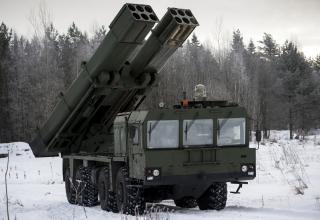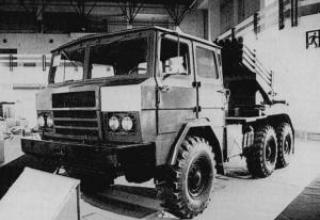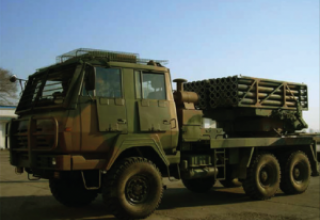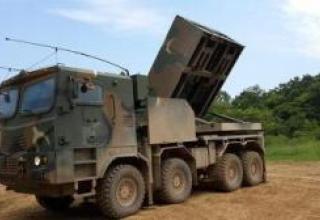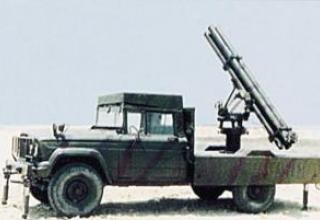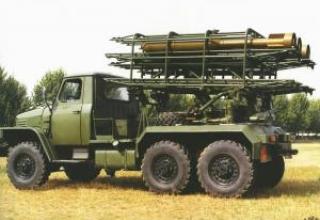The "Teruel-3" multiple launch rocket system (MRLS) is designed to engage the enemy's manpower and firepower, remotely installing minefields and setting smoke screens.
It was created in 1982 by the company "Santa Barbara" (Spain) on the basis of MLS "Teruel-1" and "Teruel-2".
It is in service with the Spanish land forces (about 100 complexes), was exported to Gabon. There is information about possible purchases of Teruel-3 MLRS by some countries in Africa and the Middle East.
Composition:
The Teruel-3 RESO consists of:
- Artillery unit mounted on the chassis of the cross-country vehicle "Pegaso-3055" (wheel arrangement 6X6),
- unguided rockets,
- fire control systems,
- of the top tie-up and communication equipment,
- of meteorological equipment.
Armored cab in the front of the chassis provides placement and protection of the combat crew (5 people) from bullets and pieces of artillery shells.
The artillery unit consists of two launching containers with 20 tubular rails mounted on a lifting frame, which is mounted on a swivel platform. The sights and panorama are mounted on the frame, used for manual guidance of the gun. Usually aiming at the angle of place and azimuth is carried out by commands from the cabin with the help of two-speed hydraulic lifting and electromechanical rotary mechanisms in the range from 0 to +55° vertically and ±120° horizontally.
To reduce dispersion during firing, the wheel chassis is equipped with four hydraulic jacks to give the starter the necessary stability. The fire control system includes a digital computing device, which allows not only to calculate the initial settings for firing, but also, depending on the nature of the target to determine the number of unguided rockets (UGM) required to kill it, the type of combat unit (BC) and the fuse.
When the missiles are loaded into the guide rail, the electrical circuit of the electroplated ignition is automatically closed. At the same time, to prevent premature or accidental launch, there is a system of safety devices that prevent accidental launch, for example, when the PU is pointed at the cabin, when it is guided and while the CDRF is moving. For firing at ranges of 10 to 28 km, unguided rockets can be equipped with two or four in-flight stabilizers that act as aerodynamic brakes. It is also possible to equip NUR with two types of engines, which provide for firing at maximum ranges of 18 km and 28 km due to different operating times. In the first version, NUR has a length of 2.04m and weighs 56kg, while in the second - 3.23m and 76kg, respectively.
Teruel-3" NUR systems are produced with two types of combat units - fragmentation and cassette.
The 20 kg shrapnel-flash BC is designed to hit the enemy's unmanned manpower and equipment and is equipped with a shock, remote or non-contact fuse.
Cassette BC with non-contact fuses have different versions of equipment:
- 42 shrapnel combat elements (950 steel balls each 3.2 mm diameter);
- 28 cumulative warheads (armour-piercing capability up to 100 mm);
- 6 anti-tank mines;
- antipersonnel mines;
- 21 smoke bombs.
Battery of six "Teruel-3" can hit the targets on the area up to 200 thousand m2 by volley fire.
In factory conditions NUR is packed in plastic containers (their shelf life in usual conditions is up to 15 years). In order to deliver ammunition and facilitate recharging of the RSZO, the firing section together with the PU includes an off-road vehicle with loading and unloading facilities. Each of these vehicles carries four containers (20 missiles each). The PU is manually charged by two numbers of combat calculation.
The auxiliary armament of the launcher consists of a 7.62 mm anti-aircraft machine gun mounted above the hatch in the roof of the cabin, which can also be fired at ground targets. The launcher has a 220 hp diesel engine, allowing it to reach a maximum speed of 80 km / h on the highway. The undercarriage, made on the wheel arrangement bhbb, provides high cross-country ability when driving on rough terrain. The equipment of the launcher includes a radio station, navigation equipment and fire extinguishing means. A heater or air conditioner can be installed at the customer's request.
Characteristics:
| Teruel-3 RESO | |
| Maximum firing range, km | 28 |
| Maximum speed on the highway, km/h. | 80 |
| Power reserve, km | 550 |
| Number of guides | 40 |
| Recharging time, min | 15 |
| The duration of the volley, s | 18—20 |
| Dimensions in camping position,m | 9 х 2.5 х 3 |
| Weight in combat position, t | 10 |
| NUR "Teruel-3" | |
| Length, mm | 3230 |
| Caliber, mm | 140 |
| Maximum flight speed, m/s | 687 |
| Weight, kg | 76 |
| Weight BC, kg | 21 |
Testing:
Strela-1 and Strela-1M complexes were widely exported by the USSR abroad. They were supplied to the countries-participants of the Warsaw Pact, to Yugoslavia, to the states of Asia (Iraq, Syria, North Yemen, India, Vietnam), Africa (Algeria, Angola, Benin, Egypt, Guinea, Guinea-Bissau, Libya, Madagascar, Mali, Mauritania, Mozambique) and Latin America (Cuba, Nicaragua), confirming their rather high efficiency and ease of use during military conflicts and during training firing.
The first use of the Arrow 1 SAM system was in the Bekaa Valley in southern Lebanon in 1981. In December 1983, these SAMs were shot down by American A-6E and A-7E aircraft (the latter, probably, was hit by portable SAMs of Strela-2 family). In the same year, several Arrow 1 SAM systems were captured by South African invaders in southern Angola.
Sources:
- Агеев И. "Испанская РСЗО "Теруэль-3"", Зарубежное военное обозрение,N7, 1986.



